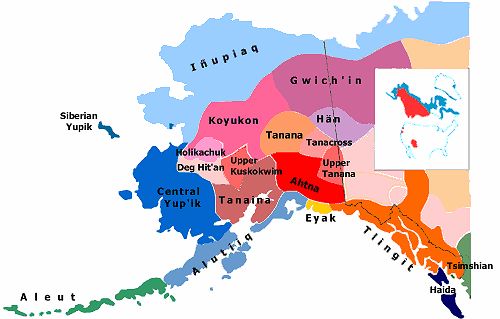The Yupik are a group of indigenous or aboriginal peoples of western, southwestern, and southcentral Alaska and the Russian Far East. They are Eskimo and are related to the Inuit and Iñupiat peoples. Yupik peoples include the following:
Alutiiq people, or Sugpiaq, of the Alaska Peninsula and coastal and island areas of southcentral Alaska. Russian explorers in the 1800s erroneously confused the Yupik people bordering the territory of the somewhat unrelated Aleut, or Alutiiq, in Yupik. By tradition, this term has remained in use, as well as Sugpiaq, both of which refer to the Yupik of Southcentral Alaska and Kodiak.
Central Alaskan Yup’ik people of the Yukon-Kuskokwim delta, the Kuskokwim River, and along the northern coast of Bristol Bay as far east as Nushagak Bay and the northern Alaska Peninsula at Naknek River and Egegik Bay in Alaska
Siberian Yupik people, including Naukan, Chaplino, and Sirenik of the Russian Far East and St. Lawrence Island in western Alaska.
Yupiit is the plural form of Yupik. Yupik means, “real person.” In the Hooper Bay-Chevak and Nunivak dialects of Yup’ik, both the language and the people are given the name Cup’ik. Yup’ik and Cup’ik can be used interchangeably to mean the same people.The use of an apostrophe in the name “Yup’ik”, compared to Siberian “Yupik,” exemplifies the Central Yup’ik’s orthography, where “the apostrophe represents a long “p” sound.The common ancestors of Eskimos and Aleuts (as well as various Paleo-Siberian groups) are believed by archaeologists to have their origin in eastern Siberia, arriving in the Bering Sea area about 10,000 years ago.
Research on blood types, confirmed by later linguistic and DNA findings, suggests that the ancestors of American Indians reached North America before the ancestors of the Eskimo and Aleut.
There appear to have been several waves of migration from Siberia to the Americas by way of the Bering land bridge, which became exposed between 20,000 and 8,000 years ago during periods of glaciation. By about 3,000 years ago, the ancestors of the Yupiit had settled along the coastal areas of what would become western Alaska, with migrations up the coastal rivers—notably the Yukon and Kuskokwim—around 1400 C.E., eventually reaching as far upriver as Paimiut on the Yukon and Crow Village on the Kuskokwim.
Yupik languages (related to Inuktitut) are still very widely spoken.
More than 75% of the Yupik/Yup’ik population are fluent in their language.
The Alaskan and Siberian Yupik, like the Alaskan Inupiat, adopted the system of writing developed by Moravian Church missionaries during the 1760s in Greenland. In addition, the Alaskan Yupik and Inupiat are the only Northern indigenous peoples to have developed their own system of hieroglyphics, a system that died with its inventors. Late nineteenth-century Moravian missionaries to the Yupik in southwestern Alaska used Yupik in church services, and translated scripture into the people’s language.
Eskimo–Aleut languages
Aleut language
Eskimo languages
Inuit languages
Yupik languages
Alaskan:
Central Yupik language (Central Alaskan Yup’ik)
Pacific Gulf Yupik language (Alutiiq)
Siberian:
Central Siberian Yupik language (Yuit)
Naukan Yupik language
Sirenik Yupik language
Yup’ik and Cup’ik Culture
